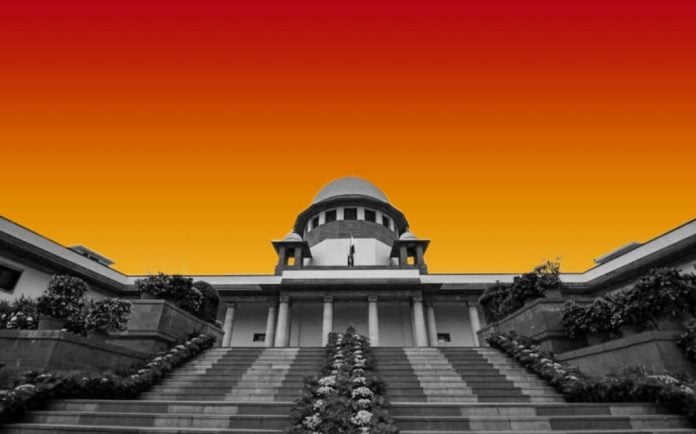The Supreme Court on Tuesday came down heavily on the Central government for filing a curative petition against the US-based Union Carbide Corporation (now Dow Chemicals), seeking additional compensation to the victims of Bhopal Gas tragedy, after a gap of 19 years.
The Constitution Bench of Justice Sanjay Kishan Kaul, Justice Sanjiv Khanna, Justice A.S. Oka, Justice Vikram Nath and Justice J.K. Maheshwari heard the curative petition, which was filed by the Union government in December, 2010, seeking additional compensation of Rs 7413 crore and re-examination of the verdict delivered by the Apex Court on February 14, 1989, wherein the compensation was fixed at USD 470 million (Rs 750 crore).
Appearing for the Centre, Attorney General R. Venkataramani said that a joint compilation has been filed.
Justice Kaul told the AG that this was a curative petition.
Senior Advocate Harish Salve, representing the Union Carbide Corporation, said that the government had filed a new set of documents.
Justice Kaul asked, “Can any fresh documents be permitted in a curative petition? If there is some data which has emerged, we may or may not be inclined to do it. But, it cannot be a re-hearing.
“The settlement was arrived at a particular stage of time. Can we say that 10 years hence, 20 years hence or 30 years hence, open the settlement on the basis of fresh documents?,” asked the Judge.
The AG contended that emerging facts may be considered, since this was an exceptional matter.
When Justice Kaul asked whether the full amount has been disbursed, the AG replied in affirmative.
Justice Kaul then asked as to how could these documents be admitted on record?
Terming the settlement amount as inadequate, the AG called for amendment in the same. He said the Centre was not asking for a settlement to be annulled, but only wanted an increase in the amount.
The Bench then asked whether the settlement brought a just conclusion? It further enquired about the scope of such a curative petition, especially at this point of time.
Justice Kaul said that this was not an issue of division of property, but a torturous claim.
The Supreme Court said that it had to decide on whether the Bench should look into something that was not a part of the record.
Regarding the amount of Rs 50 crore, which was deposited by the Union Carbide Corporation, but remained undisbursed till date, the Apex Court pulled up the government.
The AG replied that the number of claimants had gone beyond what the review judgment had in mind. This was the basis for the Union of India not being able to disburse the amount.
Salve argued that there was no re-opener clause in the settlement.
He said one important jurisdictional factor was that not only was the curative jurisdiction unknown when all this started, the Union of India filed the suit (abroad) and the Union Carbide Corporation sought transfer of the same in India.
As per Salve, an undertaking was provided that Union Carbide would abide by the jurisdiction of the Indian Court. This was how the suit started.
He said in the settlement, relief and rehabilitation was expressly excluded. Salve further said that the curative petition was evasive as it did not provide a legal principle, adding that the Corporation had raised this fact in its counter.
The Counsel said the scope of curative petition had gone beyond the issue raised in the original suit. He pointed out that the issue of relief and rehabilitation and disposal of toxic waste was not part of the suit.
The Bench then questioned the AG, if he could add to the settlement one way or the other.
The Bench noted that the incident took place in 1984, but the settlement was arrived at in 1989 (almost after five years), yet the Union Government did not have the correct data regarding the people affected by the gas leak.
Salve then said that as per the affidavit filed by Union Carbide in October, 2006, each and every claimant has received the compensation.
The Attorney General countered the argument and submitted that the settlement did not take into account the increase in the number of death and injury recorded subsequently. He added that the issue was beyond pending claims and also about the quantum of compensation.
The Supreme Court then asked, “It took 25 years for the Centre to realise that the compensation fixed earlier was wrong?
The Bench then took into account the series of events. It said in 1984-85, people died. At that time, the Centre disbursed amount ranging from Rs one lakh to Rs three lakh to the family members. After 25 years, the Central government decided to enhance it to Rs 10 lakh. By this time, one generation has gone. It flayed the Union of India, saying that it took them 25 years to decide the correct amount.
However, the Bench agreed to the point that the number of injured have skyrocketed, as the figures for minor injury have gone up astronomically.
Salve then submitted that the definition of ‘minor injury,’ as per the affidavit of the Centre was broad enough and covered “whosoever was present and filed a claim because of the trauma they had to suffer due to the gas leak”.
The arguments will continue tomorrow.


